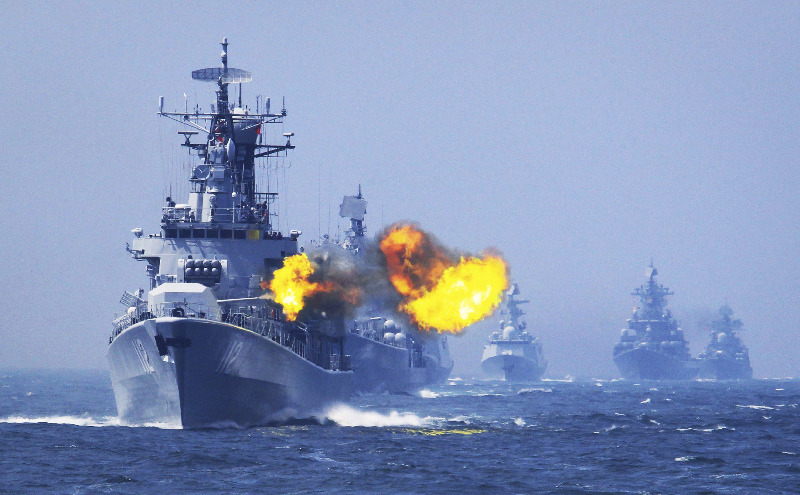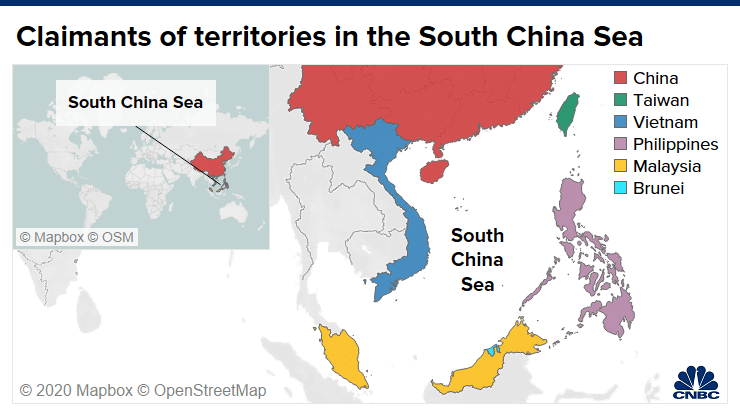Tensions in South China Sea Heat Up Over Fourth of July Weekend
Disclosure: Our content does not constitute financial advice. Speak to your financial advisor. We may earn money from companies reviewed. Learn more
Last Updated on: 25th December 2020, 05:59 am

Over the weekend, the United States and China engaged in competing uncoordinated naval and air exercises in the South China Sea. While the Chinese undertake these routinely in these waters, for the United States it was an impressive display of offensive power far away from American shores and core interests. Fully two American naval aircraft carrier groups with all of their associated ships, warplanes, and extensive supporting naval personnel were involved. According to the commander of the American aircraft carrier group the USS Nimitz, the maneuvers took place within sight of the Chinese warships, per his revelation to Reuters and the Wall Street Journal on Monday.
The Old American Adage “Don’t Shoot Until You See The Whites of Their Eyes” Comes to Mind
The Commander of the Nimitz Rear Admiral James Kirk of the U.S. Navy revealed in an interview over the phone that:
“They have seen us and we have seen them.”
His flotilla had combined with the Seventh Fleet carrier known as the USS Ronald Reagan to hold joint military exercises where the Chinese would pointedly see that the Americans were there. Not coincidentally, the engagement took place on the American holiday the Fourth of July.
Over past years, the American navy has assembled carrier strike groups like this one to project a demonstration of force into the South China Sea. The drill this time though occurred against a backdrop of dangerously simmering tensions between the U.S. and China over many underlying issues.
These included the response of the Chinese in dealing with the coronavirus pandemic, trade and technology theft tensions, and the new anti-freedom crackdown laws recently imposed on Hong Kong in defiance of international treaty law signed between China and Great Britain in 1997. The U.S. went so far as to accuse the Chinese government of using the cover of the global pandemic to advance its various territorial ambitions not only in the South China Sea, but also in the Straits of Taiwan and on the borders with neighboring behemoth power India.
Rear Admiral George Wikoff who commands the USS Ronald Reagan battle strike group told reporters that:
“The purpose is to show an unambiguous signal to our partners and allies that we are committed to regional security and stability.”
U.S. and China Flexing Military Muscles in the Sea In Direct Competition
The timing of the military drills became more significant because the government of China is under intense international pressure for its own area engagement in five days of naval military drills in the South China Sea that began on July 1st. These occurred deliberately near to the disputed Paracel Islands that at least three rival nations claim— China, Taiwan, and Vietnam.
The foreign secretary of China angrily accused the U.S. of intentionally sending its own warship flotilla over to the South China Sea in an effort to one up the Chinese in a demonstration of muscle flexing so as to drive a wedge in between China and other nations in the disputed territorial waters. The Pentagon had prior to the major military deployment announced that the point of the two carrier strike group exercise was to:
“Stand up for the right of all nations to fly, sail, and operate wherever international law allows.” The 100,000 tonnage vessels with their approximately 90 military aircraft each carry as a standard compliment are such a “symbol of resolve.”
Besides the massive military ships and warplanes, the two carrier strike groups count around 12,000 individual sailors as part of their standard deployment.
China Claims 90 Percent of the Vast South China Sea in Defiance of International Law
The problem comes down to China’s claims of around 90 percent of the trade and resource-laden South China Sea. Around $3 trillion worth of international trade (up to 1/3 of all global trade) sails through this critical waterway every year. Competing claims to the Chinese to ownership of at least part of the sea are maintained by neighbors Malaysia, Brunei, Vietnam, the Philippines, and Taiwan.
Each of these five other nations borders some part of the South China Sea. The Chinese have attempted to militarily enforce their enormous claims by constructing island naval and air bases on top of the sea’s various atolls, ironically all the while maintaining their claim to having only completely peaceful intentions.
As the military games continued, Rear Admiral Kirk insisted that the various contacts with Chinese military ships had not caused any incidents. He stated that:
“We have the expectation that we will always have interactions that are professional and safe. We are operating in some pretty congested waters, lots of maritime traffic of all sorts.”
The conflict between the U.S. and China over the strategic waterway comes down to the aggressive and internationally ruled illegal claims of Beijing’s over nearly the entire South China Sea. China claims this almost entire sea as part of its national territory. An international court ruled several years ago that China is not able to make such a vast territorial waters claim.
The United States stands as the champion of the freedom of navigating along international sea routes and waterways. This map below reveals the various six nations that border and make claims on parts of the South China Sea today:

The United States continues to accuse the Middle Kingdom for choosing to militarize and weaponize the islands in the South China Sea thanks to their construction of military installations and deployment of military hardware on them. The Spokesman of the Seventh Fleet Lieutenant Joe Jeiley stated that these drills had not been launched:
“In response to any political or world events,” but that instead they demonstrated the ways in which the American Navy “promotes security, stability, and prosperity throughout the Indo-Pacific.”
U.S. and China Engaging in Coincidentally Competing Naval Maneuvers in the South Pacific During the Same Weekend?
The United States Navy argued that its clearly timed exercises within this disputed crucial sea during the independence weekend was done to “show the flag” while sending an important message to the countries of the region, per a military expert talking with CNBC. The Navy affirmed this statement with one of their own that declared the exercises were conducted:
“In support of a free and open Indo-Pacific.”
What made the maneuvers potentially dangerous was the fact that the Chinese had begun their own sea and air exercises in the same part of the South China Sea running from July 1st through July 5th. This was no accident, per Center for Strategic and International Studies Director of Asia Maritime Transparency Initiative Gergory Poling:
“The U.S. wants to send a message that it’s not backing down, and that it’s still able to do this.” There has been too much “bad press” throughout China claiming the U.S. was no longer able to maintain its carrier fleet operations thanks to the Coronavirus pandemic. “This is about the U.S. saying that we are still in the region.”
Possibilities for Military Miscalculations Leading to War Do Exist in the South China Sea
Poling argued that America’s most recent naval moves are “definitely” intended to be a clear message to the Pacific region. Many of the U.S.’ allies have grown “very nervous” as China has been “pushing on all fronts” during the last several months. This includes the long contested border with India, the South China Sea territorial claims, and the ongoing cold war-styled conflict with Taiwan over the fate of the independent island that China claims as part of its indivisible sovereign territory. Poling added that:
″(They) want to know whether or not America still has the backbone for this. Aircraft carriers probably have very little to do with a modern fight in the region, but this is about showing the flag.”
Poling was asked about the dangers of a potential military miscalculation that led to hot conflict in the region. He opined that odds of this happening are lower as neither China nor the United States want a war. Yet he could not completely discount the possibility of an accident occurring.
He revealed that China’s endeavors to halt the U.S. “Freedom of Navigation Operations” like these have intensified, becoming “more and more aggressive” with China “highly sensitive” to what they see as perceived weakness courtesy of the Coronavirus pandemic. According to Poling’s interview with CNN:
From the American point of view, the military is “committed to not being seen as a paper tiger. There’s a small but non-zero chance of accidental escalation. Operating two carrier strike groups in the Philippine Sea and South China Sea provides advanced training opportunities for our forces and provides combatant commanders with significant operational flexibility should those forces be called upon in response to regional situations.”
The various already brewing tensions between Washington and Beijing have only been stoked recently by the Chinese moves to enforce a stifling new security law over Hong Kong. This added to concerns expressed by the United States Department of Defense that such Chinese operated military drills throughout the South China Sea are intended to double down on their “unlawful maritime claims” that will destabilize the region. The U.S. Secretary of State Mike Pompeo tweeted that:
“America agrees with our Southeast Asian friends. The People’s Republic of China military exercise in disputed waters of the South China Sea is highly provocative. We oppose Beijing’s unlawful claims. Period.”
The news this week from the South China Sea not coincidentally during the American Independence Day and weekend is not conducive to peace and stability in financial markets either. It is a concerning geopolitical reason for why gold makes sense in an IRA. Today it is easy to acquire some IRA-approved precious metals if you would like to add some safe haven holdings to your investment and retirement portfolios. You can read all about Top Gold IRA companies and Gold IRA allocation strategies to learn more.



 Silver
Silver Gold
Gold Platinum
Platinum Palladium
Palladium Bitcoin
Bitcoin Ethereum
Ethereum

 Gold: $2,631.42
Gold: $2,631.42
 Silver: $29.86
Silver: $29.86
 Platinum: $938.75
Platinum: $938.75
 Palladium: $921.81
Palladium: $921.81
 Bitcoin: $95,667.01
Bitcoin: $95,667.01
 Ethereum: $3,322.64
Ethereum: $3,322.64